Hiking Humphreys Peak: Beginner and Expert Perspectives
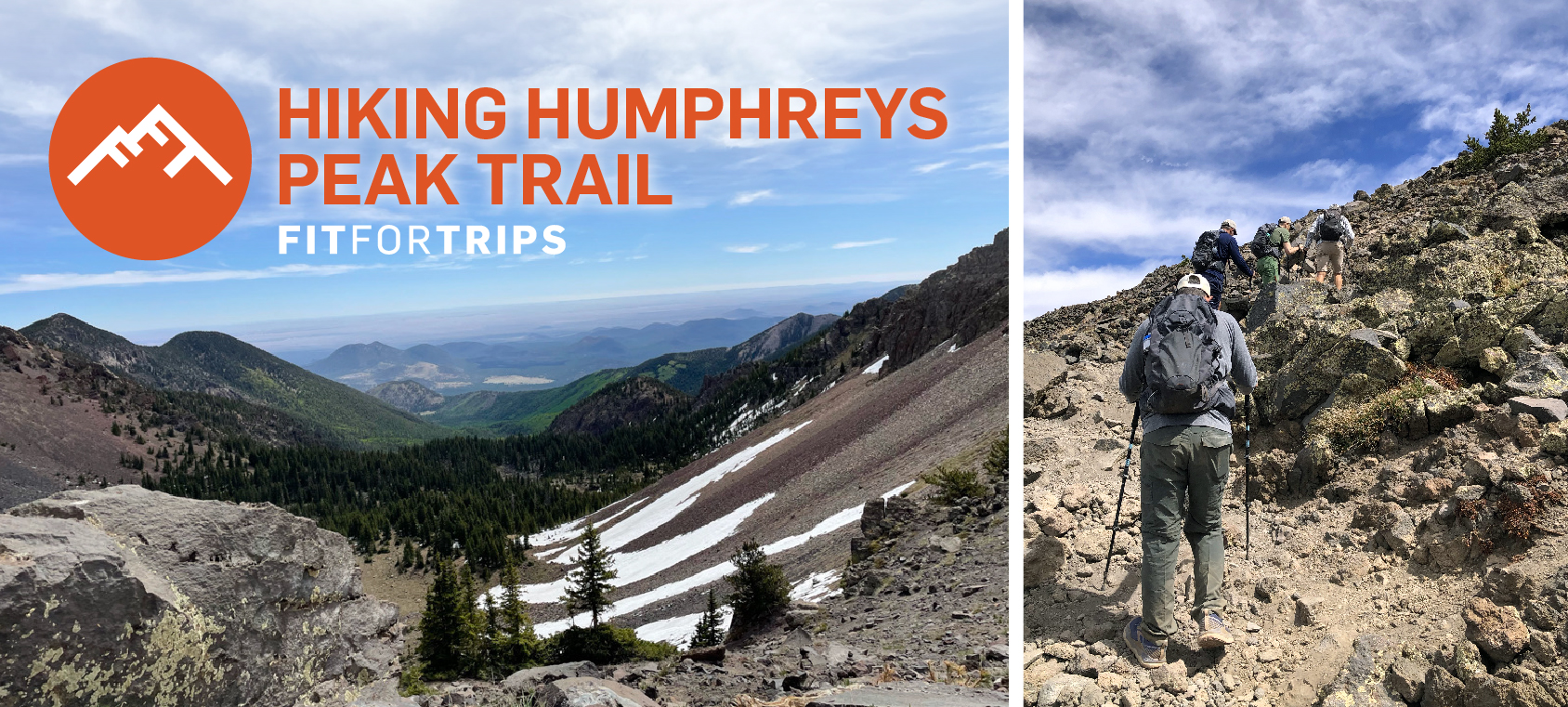
Humphreys Peak is the highest point in Arizona, towering over the Kachina Peaks Wilderness at an impressive 12,637 vertical feet. It’s one of the most accessible western mountains to summit, making it a great introduction to peak bagging. Hiking the Humphreys Peak Trail is a dream come true for adventurers of all levels, promising unforgettable views. The mountain overlooks some of northern Arizona’s best features. From the summit, you can see surrounding mountains, forests, deserts, and nearby Flagstaff. On a clear day, you can even see the north rim of the Grand Canyon. We’ve got the lowdown on what it’s like to hike the Humphreys Peak Trail, straight from the mouths of two hikers just like you.
The Humphreys Peak Trail is the second installment in our three-part series highlighting the best of Arizona hiking. We’ve teamed up with expert wilderness guide Will Burkhart and two average hikers to showcase the best beginner, moderate, and advanced trails in the Grand Canyon State. The Humphreys Peak Trail is the intermediate trail of the three hikes. Be sure to check out our comprehensive guides on the Cathedral Rock Trail and Rim to Rim Trail.
A Beginner’s Guide to Hiking the Humphreys Peak Trail in Flagstaff
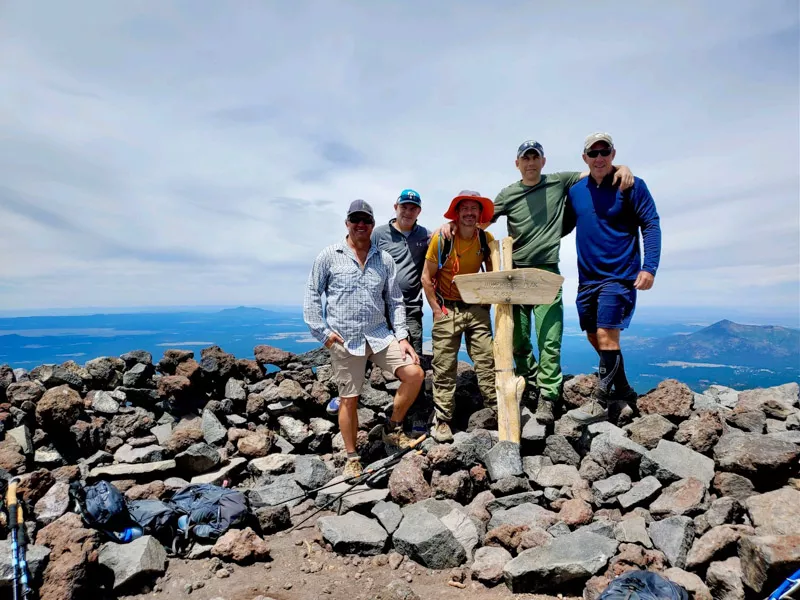 Standing at Mount Humphreys Peak summit at 12,637 ft.
Standing at Mount Humphreys Peak summit at 12,637 ft.
The Humphreys Peak Trail is the second trail in our “Best of Arizona” hiking series. It’s a great trail for intermediate hikers and beginner peakbaggers who want to challenge their fitness while basking in the incredible scenery of Arizona’s mountains. Our beginner hikers prepared for this trip with the help of Marcus Shapiro at Fit For Trips. Marcus created custom fitness plans for each hiker so they could get in the best shape for their Arizona hiking adventures. This is their experience hiking the Humphreys Peak Trail.
Trail Stats
Distance: 10.7 miles roundtrip from the ski resort—that’s the route listed under “Humphreys Peak” in trail apps, like AllTrails.
Elevation Gain: 3,400 feet, with a maximum elevation of 12,637 feet.
Difficulty: Hard
Season(s): Spring, Summer, Fall
Fees: None. However, you need a permit to camp on Humphreys Peak.
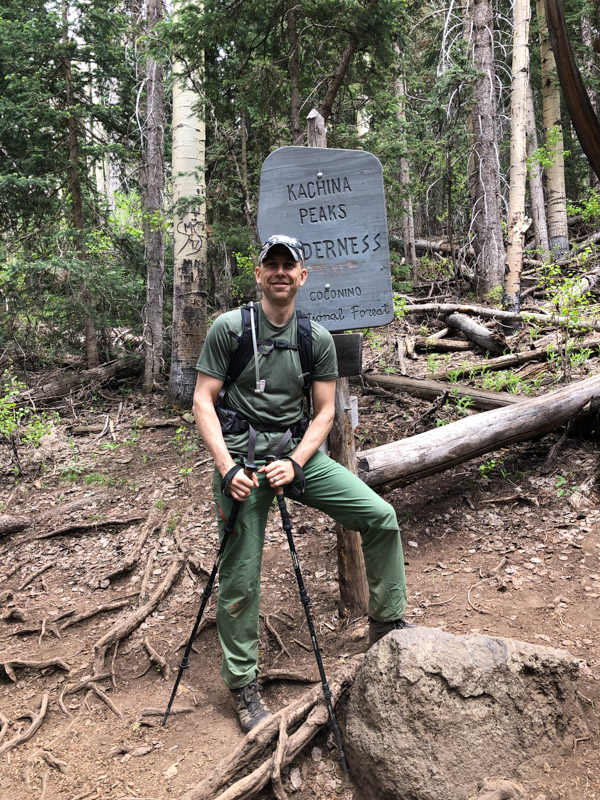 Justin is 15 minutes into the Humphreys Peak trail recently departed from Snowbowl parking lot.
Justin is 15 minutes into the Humphreys Peak trail recently departed from Snowbowl parking lot.
Hiking the Humphreys Peak Trail: The Hiker’s Perspective
Meet your fellow beginner hikers, Mike and Matt. They’re both average hikers just like you who wanted to embark on a new adventure and challenge their fitness. Mike and Matt live in Florida, so they’re used to hiking flat trails near sea level. They wanted to see what it’s like to hike Arizona’s best trails.
Hiker Mike S.
Hi, I’m Mike. I was born and raised in Miami and now live in Highland Beach, Florida. I wanted to hike the “Best of Arizona” trails to enjoy a new adventure, spend time with friends, and challenge myself. I’m new to hiking mountainous trails, so I didn’t know what to expect. I enjoyed my training and preparation. Without Marcus Shapiro at Fit For Trips, I wouldn’t have been able to prepare properly. It was a rush to accomplish my goals and made for an amazing adventure.
Hiker Matt D.
Hey, I’m Matt. I grew up in Miami and currently live in Plantation, Florida. I exercise a few times a week but I’ve never attempted a three-day hiking itinerary. Living in South Florida, I didn’t have a clue how to prepare for a hike with elevation gain and distance. So I asked Marcus Shapiro at Fit For Trips to provide a routine I could complete in time for the hike. Getting together with friends for a physically challenging adventure was the perfect trip.
We asked Mike and Matt to share their experience with you so you know what to expect when it’s your turn to hike the stunning Humphreys Peak Trail. This is what they had to say.
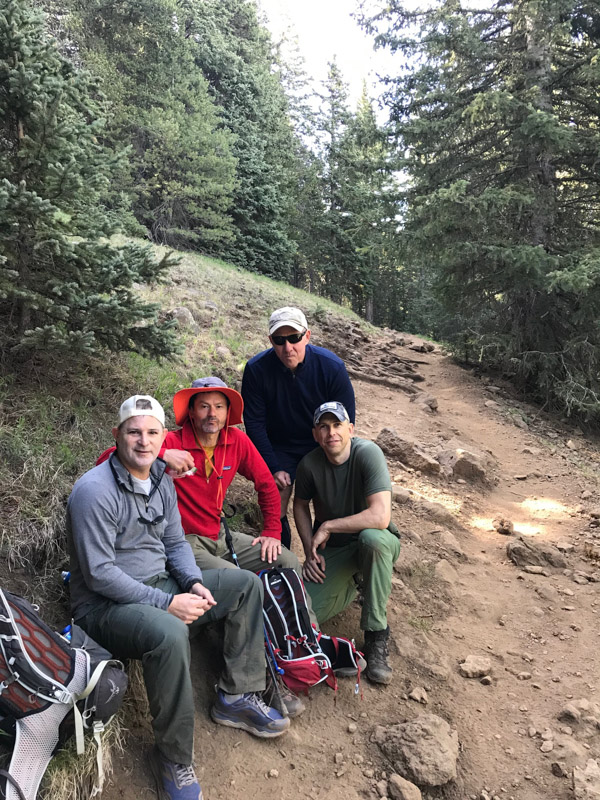 Resting on Humphreys Peak trail just below treeline about 11,600 ft. Matt on the left and Mike in the back.
Resting on Humphreys Peak trail just below treeline about 11,600 ft. Matt on the left and Mike in the back.
What’s the best thing about hiking the Humphreys Peak trail?
Mike: The view from the top of Mount Humphreys. Top of the world, baby.
You can actually see the Grand Canyon from Humphreys Peak because you’re at the highest point in Arizona. You can see a lot of mountains so you get a sense of achievement when you reach that point. You’re looking down and saying, “look what I accomplished.”
Matt: I knew in advance that we were hiking ten miles, so I told myself I better be prepared. When I trained for the hike, I was walking on flat land. I knew we’d be climbing 3500 feet, without knowing what altitude feels like. That was very interesting.
Halfway through the hike, I was unsure if I was feeling the altitude. I was thinking, “okay, I’m getting tired” or “I’m feeling tired, but my legs are fine. My body has enough energy.” Even so, I was feeling a little lightheaded. It wasn’t overwhelming; I knew that I was getting into a higher altitude. It made me feel like I couldn’t hike as fast as I could at lower altitudes.
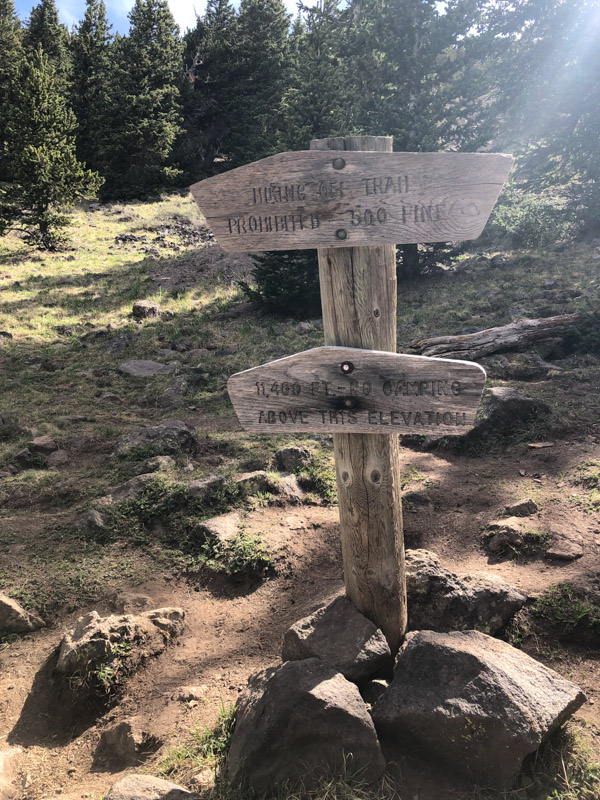 Camping on Mount Humphreys is prohibited above 11,400ft. Sign is about 20 min from saddle. Saddle to summit about 1 mile.
Camping on Mount Humphreys is prohibited above 11,400ft. Sign is about 20 min from saddle. Saddle to summit about 1 mile.
What’s the hardest part of hiking the Humphreys Peak Trail?
Mike: The hardest part was finding my footing and getting stabbed by rocks in my toes because of my soft-top shoes. I also struggled with the trip back down. I was sliding and losing my footing because I didn’t have better shoes. Rocks were hitting me in the foot. But beyond the footing issues, I enjoyed it.
Also, I didn’t realize I was supposed to have an altitude problem. At the top, Will asked if I was having issues with the altitude. I said, “no, was I supposed to?” And he said, “when you don’t know you’re supposed to have a problem, you generally don’t.” It wasn’t in my head because I don’t know anything about altitude. Then, on the way down, I got a headache. And I thought, “maybe I’m having a problem with the altitude.” But I think it was in my head. When you put something in your head and it happens even when you don’t know it’s supposed to, it’s not an actual problem. Anyway, it didn’t bother me. I don’t know why.
Matt: The hardest part of the hike was the increasing altitude. Since Will had us stay in Flagstaff, where we were already at a higher altitude than Florida. I didn’t know if spending a night at a higher altitude would prepare us for Humphreys Peak, or if we’d need additional time.
I recall climbing to the top and having an epiphany. This is the greatest thing I’ve ever done!” And it turned out I actually hadn’t reached the peak yet. Here I was enjoying my victory before actually getting to the top. Maybe it had something to do with false peaks, or maybe I was delusional. I remember talking about how great it was to be near the peak as opposed to actually reaching the peak.
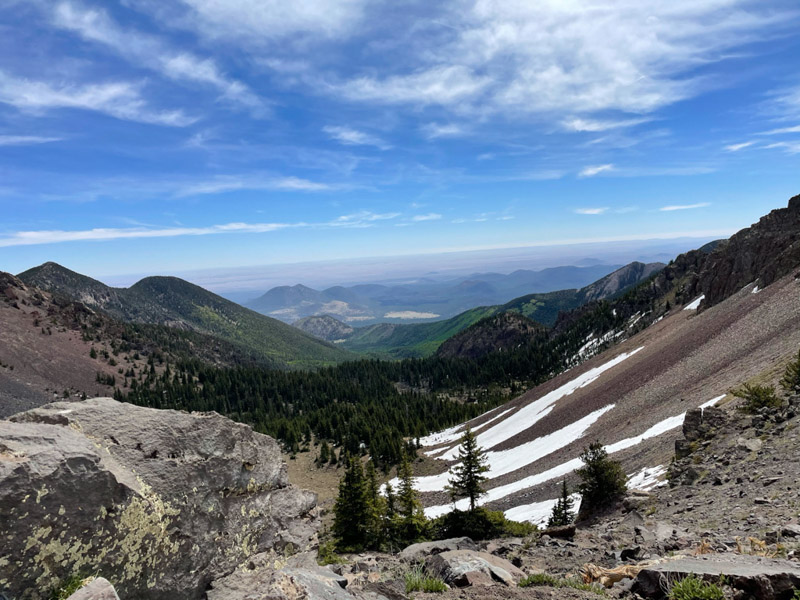 Looking west from the ridge on Humphreys Peak trail.
Looking west from the ridge on Humphreys Peak trail.
How is Humphreys Peak different from Cathedral Rock or the Grand Canyon Rim to Rim?
Mike: It’s totally different from both of those hikes. It’s a lot more vertical; straight up and straight down. And it was more technical in some areas, so you need good footing. Cathedral Rock was about enjoying the beauty of the hike. This hike was more vertical at the highest point. It was more technical, getting around some of the rocky terrain. I had to make sure my footing was good, so I didn’t slide or step on the wrong rocks. Making sure I didn’t fall, slip, or get stabbed in the foot by a rock.
Matt: The biggest difference was the altitude and terrain. At the top, we hiked through volcano rock, a terrain we hadn’t seen on the Cathedral Rock Trail. This rock was black, not red. And we hiked over big boulders, which was different from the Cathedral Rock Trail. Those rocks were smooth, soft, and rounded. This hike was more challenging, especially since we had to use our poles; they were necessary on the Humphreys Peak Trail. I think the hike would have been difficult without the poles.
As long as we were in the trees, the hike was relatively easy. It was a constant rise in elevation, continuously walking up. Once we got above the trees, we were hiking over “steps”—black boulders and rocks. We had to ascend one rock at a time, in higher elevations; that was tough. I had to slow down considerably when we got into the higher elevations.
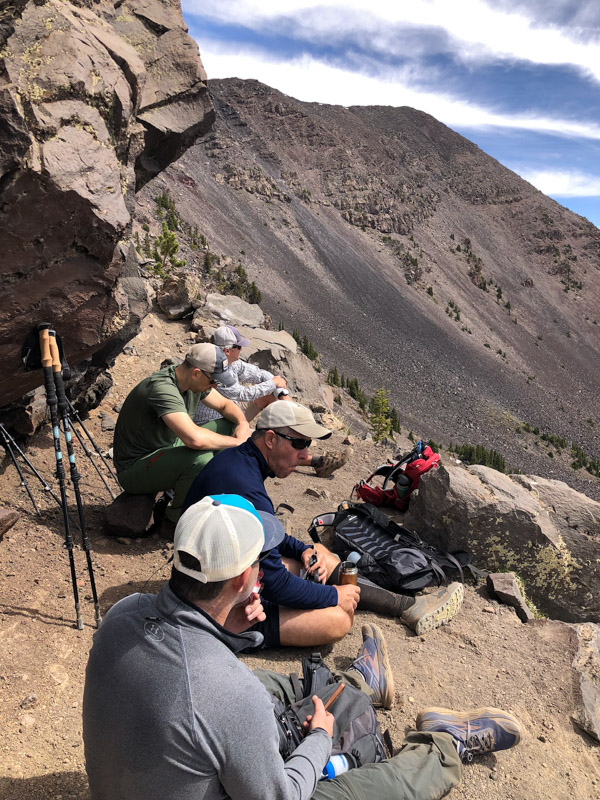 Snacking and resting at saddle before the final Humphreys Peak summit.
Snacking and resting at saddle before the final Humphreys Peak summit.
How was your preparation helpful for hiking the Humphreys Peak Trail?
Mike: To enjoy this hike, it helps to be in shape. It’s longer and more challenging than the Cathedral Rock Trail. If you’re not in shape, you’ll be huffing and puffing, and you won’t really enjoy the environment and scenery. You’ve got to be ready for that kind of stuff. The stair-climbing and slopes on the side of the bridge helped me a lot.
Matt: If I hadn’t trained on the stairs, I would have struggled going over boulders in that higher elevation. I would have struggled with the altitude. Training on the stairs helped my legs (and the rest of my body) to be prepared. The training made it easier to adjust to the altitude. I don’t really like long-distance walking so that training was important too.
And I wasn’t in my best shape for the Humphreys Peak hike. I trained a lot, but I didn’t really change my eating habits. It didn’t make much of a difference on the Cathedral Rock Trail, but when we hiked Humphreys Peak, I started thinking about my diet. I still have a lot to learn about the way I eat. On the trail, I learned that I eat too much sugar on a daily basis and don’t know how to balance fiber and proteins. But I’ve since cut out a lot of sugar, and I wonder what I could have done differently to have more energy on the hike. The whole thing was an incredible learning experience.
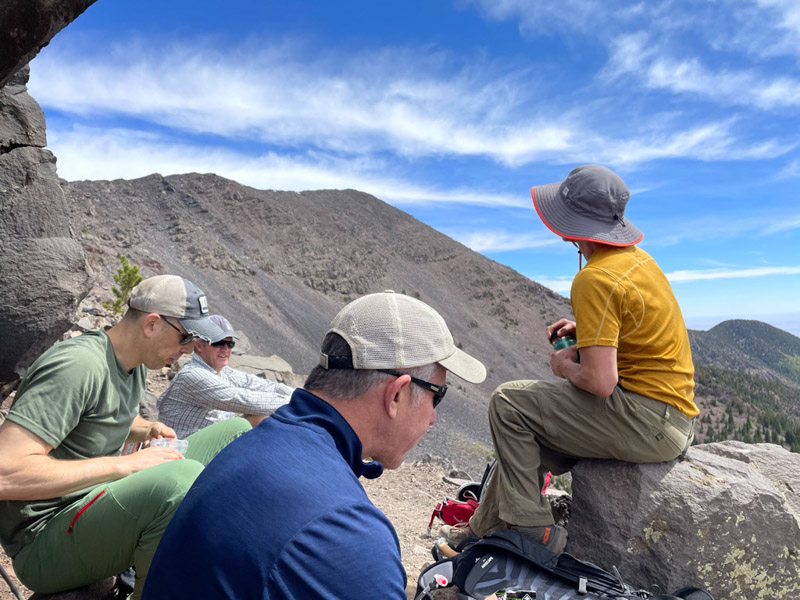 Resting at saddle. Marcus Eying Humphreys Peak in the distance.
Resting at saddle. Marcus Eying Humphreys Peak in the distance.
What gear is important for hiking the Humphreys Peak Trail?
Mike: Always bring two different pairs of shoes. Make sure one of them has a hardtop, so your feet won’t get stabbed by rocks. You might want to bring a calf sleeve. I was experiencing shin splints. I put on a calf sleeve and then I was fine. And I brought knee braces. In general, you should be prepared for the worst.
Matt: The poles. Using them on the stairs section made a huge difference.
Do you have any anecdotes about hiking the Humphreys Peak Trail?
Mike: It was a great hike; enjoyable and challenging enough to feel like you accomplished something. Cathedral Rock was a great introduction. But on Humphreys Peak, I felt like we were really getting somewhere and being challenged. Feeling comfortable with that challenge helped me build confidence.
Matt: The funniest thing to me about Humphreys Peak was Mike is talking his way through the whole hike. That’s amazing to me. He didn’t stop talking the whole way.
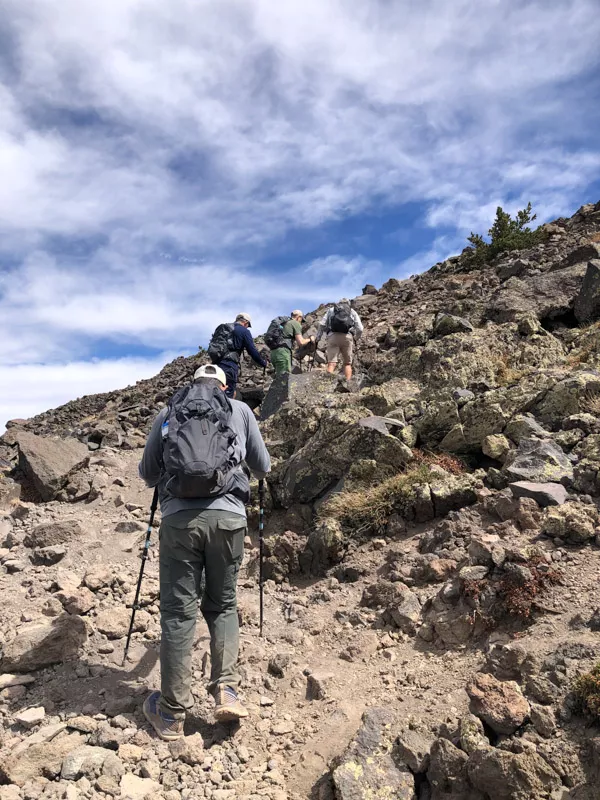 One of the hardest parts of the hike. Abut 1 mile from Mount Humphreys peak.
One of the hardest parts of the hike. Abut 1 mile from Mount Humphreys peak.
Why do you recommend hiking the Humphreys Peak Trail?
Mike: To get to the highest peak in Arizona. That alone is a big accomplishment and you feel like you conquered Arizona’s highest peak. And, it’s different than Cathedral Rock and the Grand Canyon. This hike is a simple climb straight up and straight down. There wasn’t as much to it, and you’re maneuvering around a lot more rocks. Humphreys Peak is a different experience than the other two.
Matt: The view. The fact that I was able to have that experience, climbing to 12,000-plus feet. It’s such a great feeling. I absolutely recommend the Humphreys Peak hike.
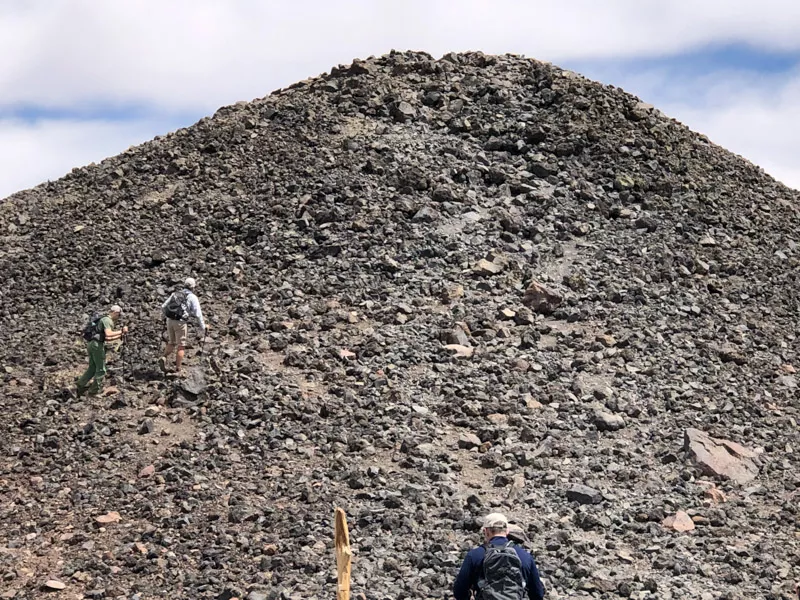 Final approach to Mount Humphreys Peak summit.
Final approach to Mount Humphreys Peak summit.
Hiking the Humphreys Peak Trail: The Expert’s Take
Meet Will Burkhart, our expert wilderness guide. Will is the founder and CEO of Bad Ass Adventures, an Arizona-based guiding company that specializes in land and water expeditions. With over 20 years of experience, Will has led clients from all backgrounds through unforgettable adventures all over the world. In addition to being a WFR-certified guide, he helps people master Dahn Yoga, Tai Chi, and Crossfit. Will combines his fitness coaching and wilderness leadership to create some of the most unique adventures in the United States.
We asked Will to answer all your questions about hiking the Humphreys Peak Trail. This is what he has to say.
When can you hike Humphreys Peak?
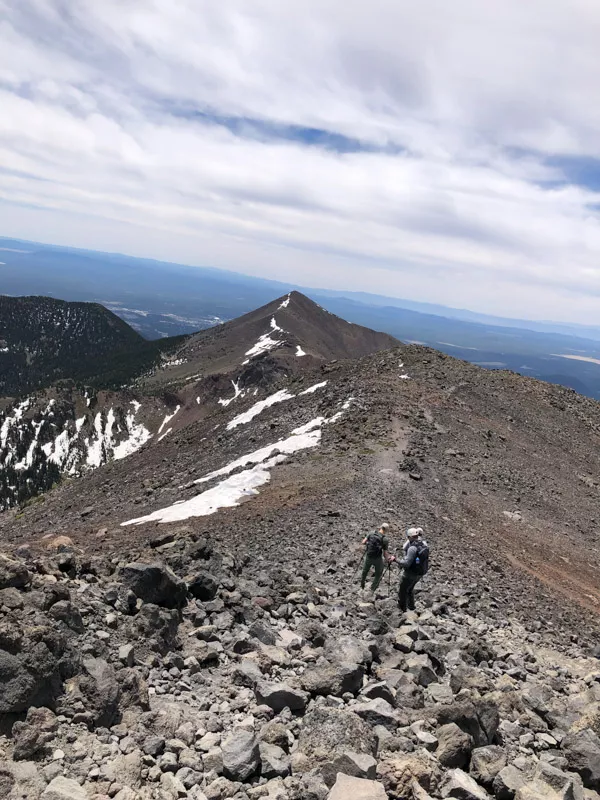 Descending Humphreys Peak eyeing Agassiz Peak in center-background.
Descending Humphreys Peak eyeing Agassiz Peak in center-background.
Will: You can hike it year-round, depending on the conditions you want. Humphreys Peak gets its first snow of the season in November. By January, it has snowpack. The snow melts in late May or early June. Be prepared if you’re going to hike through the snow.
The monsoon season is from mid-July to the end of August (sometimes mid-September). You don’t want to be on the mountain in the afternoon with all the storms rolling in. But you can hike it if you start early in the morning. Plan to be completely off the mountain no later than noon.
How long does it take to hike Humphreys Peak?
 Descending from Humphreys Peak now at the first false summit.
Descending from Humphreys Peak now at the first false summit.
Will: It depends on your pace. The hike is 10 miles long, roundtrip, with an elevation gain just under 3,400 feet. If you’re a two-mile-an-hour hiker, it’s going to take over five hours. The average person hikes about a mile-and-a-half per hour, so it takes six to eight hours to complete. Mount Humphreys has two false summits. When you get toward the end of the hike, you keep thinking, “okay, there’s the top, there’s the top.” It psyches you out.
People who run Mount Humphreys—trained athletes and trail runners—can be up and back down in three hours or less. If you’re fit, it can take five hours or less.
Is Humphreys Peak a hard hike?
Will: Humphreys Peak is rated as a Class 1 peak, which is the easiest mountain rating that involves less than a day of hiking and no technical exposure.
Is Humphreys Peak dangerous to Hike?
Will: If you’re prepared, it’s not dangerous. Mountaineering involves some risk, though. There’s an altitude component, but it’s rare to get altitude sickness on Mount Humphreys. You may get headaches and shortness of breath, but that’s usually it.
The other factor is rockfall. Rocks fall down mountains all the time, and you don’t want to be in their path. The rockfall danger on Mount Humphreys isn’t significant, but it’s still a danger (on any mountain).
And the third factor is the weather. Weather is one of the top dangers when you’re hiking any mountain because it can change very quickly. A lot of hikers aren’t prepared for the weather with proper clothing and gear. Always check the weather, especially the wind and storm activity. If you see dark clouds while you’re hiking, or if you hear thunder or see lightning on the horizon, turn around. The weather will reach you faster than you think, and you don’t want to be on a mountain during a storm.
Can you drive up to Humphreys Peak?
Will: No, you can’t drive all the way to the top. There are two main access roads. The first is the paved road into the Arizona Snowbowl Ski Resort. The trailhead at Snowbowl is about 9,200 feet. And the other is a Forest Service Road to the Lockett Meadow route, where you’ll need a high-clearance vehicle.
Can you camp on Humphreys Peak?
Will: Yes, there are areas where you can disperse camp. Above certain altitudes, you can’t camp. It’s right around 11,000ft, above the tree line. The challenge of camping on Humphreys Peak is finding a level piece of ground to sleep on. The main considerations are water sources and finding a comfortable spot.
There’s a really nice primitive campground on the east side of Mount Humphreys called Lockett Meadow. They have sites with vault toilets. Hikers who don’t want to disperse camp use that campground. It is a first-come-first-serve campground, so you can’t make reservations. And there’s NO water, so you need to bring enough for the duration of your stay.
Is Humphreys Peak the highest point in Arizona?
Will: Yes.
What mountain range is Humphreys Peak in?
Will: Mount Humphreys is part of the San Francisco Peaks. Technically, they’re volcanoes.
What would you tell a first-timer about hiking Humphreys Peak?
Will: I always recommend spending a night (or longer) in Flagstaff to acclimate. The elevation is at almost 7,000 feet. Try to get 24 hours at that altitude. If you think the hike will take five hours, plan for six hours, or longer. Bring enough water and food for that allotted time.
Be aware of false summits; once you get to the saddle and rocky parts, expect to hike through a couple of false summits. Don’t get discouraged, you’ll get there. But the mountain will psyche you out if you’re not ready for those false summits. It’s a beautiful hike. On a clear day, you can see the north rim of the Grand Canyon to the northwest.
I consider it an easy mountaineering route. It’s high, but not too high. It has distance, but it’s not crazy long. There are steep sections, but not so steep you have to scramble. If you have time, check out the easier mountains in the area to get warmed up. If you have three or four days in the Flagstaff area, hike one of the easier peaks and then knock off Humphreys Peak as your final test. Some great warm-up hikes with incredible views are Elden Mountain, (9,298 feet), Sitgreaves Mountain (9,390 feet), and Kendrick Peak (10,423 feet).
Do you have any other thoughts?
Will: Yes. Most tourists go to the Grand Canyon, Sedona, and Humphreys Peak. There are definitely other areas in southern and eastern Arizona worth checking out. Three great options are the Sky Islands, the Chiricahua Mountains, and Aravaipa Canyon. Those areas are amazing, without the crowds.
If you’re looking for a wilderness experience, the Superstition Mountains are just outside of Phoenix. There are some amazing hikes. If you get in deep enough you’ll hardly see anyone.
If you come to Arizona, go to the Grand Canyon, Sedona, and Mount Humphreys. It’s a beautiful area to hike. Once you hike those top two or three, there’s still so much more.
For travelers who like peak bagging, I offer a trip called the Arizona 7 Summits. You get to climb seven peaks in the time you have allotted. The list of peaks you’ll bag depends on your desired difficulty, time, and budget; it’s highly customized. Humphreys Peak is on that list, as well as Baldy Peak (11,409 feet) Kendrick Peak (10,423 feet), Chiricahua Peak (9,763 feet), Mount Lemmon (9,160 feet), Brown’s Peak (7,659 feet), Picacho Peak (3,374 feet), Camelback Mountain (2,707 feet), and more. It’s a great way to train for the Rockies or other mountainous areas while experiencing the diversity of Arizona mountaineering.

Matt
Will, Great info so thank you for sharing! I am hoping to do Humphrey’s Peak in early November. In your experience, what should I expect the weather and trail conditions to be?
Marcus Shapiro
You can reach Will by visiting this site: https://www.badass-adventures.com/contact